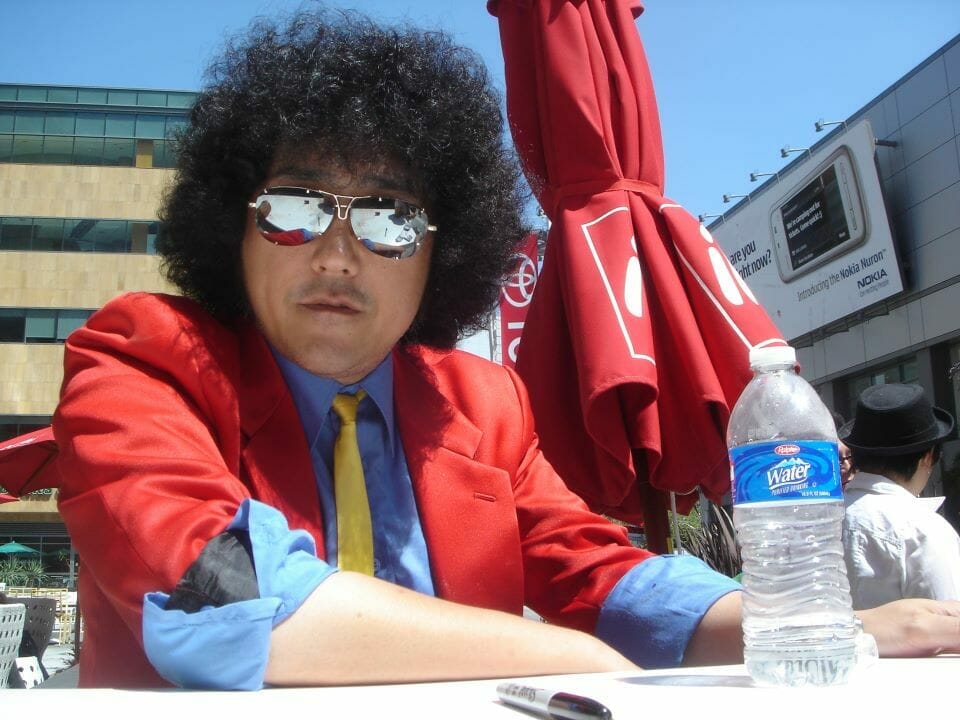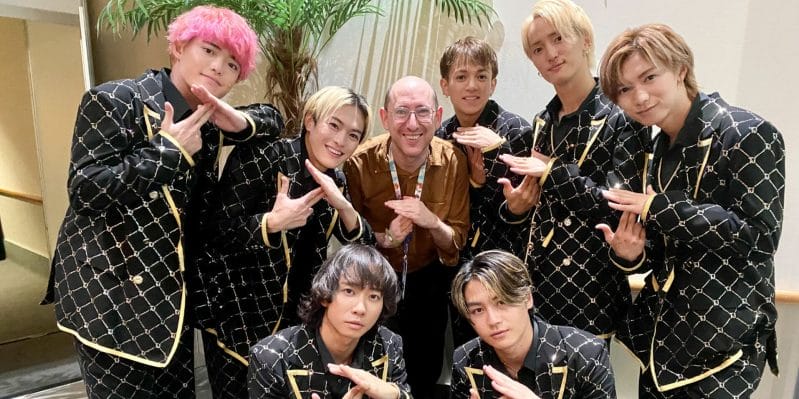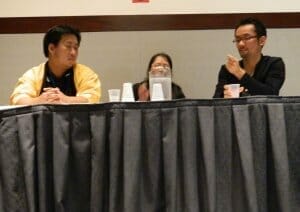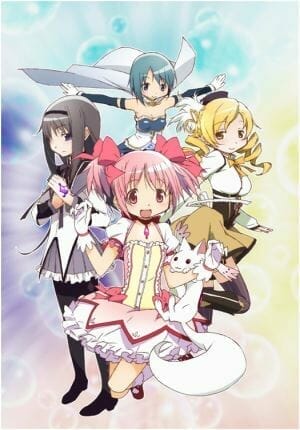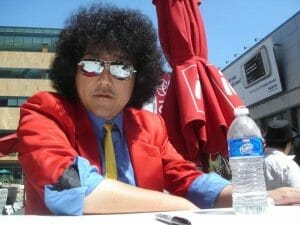 Anime Boston 2013 was host to a number of notable guests. From two figures behind Sword Art Online, to singer-songwriter (and former Seat Belts member) Raj Ramayya and voice acting powerhouses like Monica Rial and Stephanie Sheh. However, among the many guests in attendance, one name seemed to stand out above the rest. Shinichi Watanabe, known by friends and fans alike as “Nabeshin”, is an anime director known for high larger-than-life persona, crude sense of humor, and luxurious afro in addition to his work. Watanabe’s helmed numerous fan favorite works like Excel Saga and The Wallflower, and loaned his talents as an episode director, storyboard artist, and even as a character insertion to countless projects. Few can mistake his trademark red jacket, shades, and fro in a crowd, and he’s damn proud to point that out.
Anime Boston 2013 was host to a number of notable guests. From two figures behind Sword Art Online, to singer-songwriter (and former Seat Belts member) Raj Ramayya and voice acting powerhouses like Monica Rial and Stephanie Sheh. However, among the many guests in attendance, one name seemed to stand out above the rest. Shinichi Watanabe, known by friends and fans alike as “Nabeshin”, is an anime director known for high larger-than-life persona, crude sense of humor, and luxurious afro in addition to his work. Watanabe’s helmed numerous fan favorite works like Excel Saga and The Wallflower, and loaned his talents as an episode director, storyboard artist, and even as a character insertion to countless projects. Few can mistake his trademark red jacket, shades, and fro in a crowd, and he’s damn proud to point that out.
However, his persona was temporarily torn away on April 7, when Nabeshin suffered a heart attack. The news roared through anime news sites, forums, and social media. It was at this time that the Anime Boston staff began to scramble. Two days later, they announced that Watanabe was still scheduled to appear at the event, along with military consultant Yasuhiro Koshi. As part of their official statement, the Anime Boston staff stated the following:
“We have been in touch with Mr. Watanabe over the past few days since his heart attack on Sunday. He has given us all indications that he will be able to attend Anime Boston 2013 this year.
As such, he is in our thoughts and we hope for his successful recovery.”
A few days later, my interview with him was approved, and the task of crafting questions began. But really, what does one ask in a situation like this? Is it proper to bring up his recent ailment, or would it be morbid? Should things carry on as usual? Do I prepare questions in for scenario in advance, just in case? Where does one draw that line, where the questions go from curious inquiry to a gauche, borderline insensitive interrogation?
Before I knew it, it was the day of the interview. About eight of us were seated in a room, as Nabeshin and his translater sat at the front. He was in good spirits, as he started singing a little tune into the reporters we deposited the table. After we gave our introductions, there was a notable hush for a moment.
The first one to break the ice was John Reilly from the Boston Bastard Brigade, who asked the first question: “How are you feeling?” Nabeshin was quick to answer this. “Well, since I got here, I’ve gone to the bathroom three times! Oh man, the girls are clapping! I don’t really know what they’re… it’s a little embarrassing. Oh well. I said it,” he quipped, as the room erupted in laughter and applause.
Oh yeah, this was going to be one of those interviews, where we just sit back, go with the flow, and have a good time.
Nabeshin continued to tell the tale of his two-week hospital stay. During his time there, the director learned a valuable skill. He learned to control the heart monitor’s beeping by clenching his body, the very thought of which had several members of the junket snickering and giggling. The laughter grew louder, as Watanabe recalled a conversation with the doctor, where his primary question was “how many times a day can I have sex,” which left the doctor flabbergasted and saying “I mean… I guess as much as you want. Just be careful!”
As the question line reached me, things had shifted away from talk of recovery nookie and heart monitor antics. We had shifted back into the realm of the industry, so I ran with the conversation at hand, and asked a straightforward two-part question: “When did you first develop an interest in animation and filmmaking, and how did you first get involved in the anime industry?”
Nabeshin took a thoughtful tone, as he recalled events long past. “I actually enjoyed watching anime since I was little, even before I got into elementary school,” he mused, “yeah, probably since kindergarten I just loved watching anime.” He gained a sentimental tone as he continued, his words lingering just a bit longer and his tone growing just a bit heavier with each passing syllable. “And then, when I got to around second year in elementary school, I was thinking about it and I thought ‘well, you know, it’d be really cool if this story existed or that story existed’, so I actually just started drawing my own manga. And then, when I finally actually got interested in manga and thought about becoming a manga artist, I was probably around eighteen when I graduated from high school.”
As he continued, his tone brightened, and a fire began to swell within the director. He thought for a short moment and continued:
And then about a year later, when I was about nineteen, what I learned was that it’s actually easier to go into the anime world than it is to become a manga artist. So, that took about a year to learn. So then I went to technical school, a specialized school for learning how to become a manga artist. And then, at around 22, that’s when I started, after having studied in-between.
Kind of, though, when I think back on it now, when I realize that I’ve chosen sort of a regular path and become, like, a salaryman or something like that, I’d probably at this point be a company president or something like that! So when I think about it like that, I kind of regret becoming an anime director just a little bit! But then, on the other hand, I think about how I get to come to all of these awesome conventions and meet all of these awesome people, and I have a fantastic time every time. And I think about it, I’m like “you know what? No!” I think that I was meant to be an anime director. I love my life. It’s awesome.
As the questions continued, Nabeshin shared anecdotes on his work on Excel Saga, other industries he’d take, and how he chooses which audiences to cater to. By the time my chance rolled around again, the tone had shifted again, and the questions had again changed tone, and the mood had become lighter. The junket was slinging jokes with Nabeshin, and he was more than happy to oblige. So, in turn, I decided to shift the tone of the question a bit to match: “What led you to insert yourself into your titles, and how does it feel to be known for your work, your character, and your magnificent afro?”
Nabeshin thought about this for a moment, before he gave an answer:
So, I guess, really when it started, I wasn’t directing my own. I was actually helping out another director doing his anime,” he noted. “So at the time, when I was working with that director, he basically said ‘Well, you know, I’ve got this interesting work and these kind of cool characters, so why don’t you try doing some voice acting for it?’ So I did! So I thought about it, and, you know, I didn’t want to just make it just a voice. I wanted to really kind of express a certain sort of personality into it and originality into it, so I did, and I thought it was actually a lot more interesting that way!
The room chuckled a little, as he began to talk about how he crafted his trademark persona, of the afro and red jacket. “And at that time was when I actually started doing, you know, like really using the afro a lot, and wearing the red jacket and the yellow necktie, and so I figured it might be interesting to put that part of the character into it as well.” There was a palpable sense of amusement in his voice, as he continued his proverbial anime origin story. “[O]f course, animation is fundamentally about drawing pictures as a form of expression, but what I think is also important, or what I sort of like to focus on is putting myself into those pictures, and therefore creating a form of expression. So, I mean I really think that that’s, for me at least, what’s been really important about it.” He smiled a little as he spoke, every word containing the trademark gravelly tone that people have learned to recognize over the years. “So I mean, I really like animation, and I also really like myself! So, combining the two, then, you get animation of myself, that is something I really really like, and yeah, I think it’s great!”
The questioning continued around the room, as questions led to where the next Nabeshin anime appearance would be, his stylistic influence, his musical choices. Sticking with the musical theme, I let my final question run with the most musically charged show in Nabeshin’s resume: Nerima Daikon Brothers. The question was “What led to you adapt the show as a musical, and do you see yourself doing another full series in that format?”
Nabeshin was quick to answer this, as he began to recollect the show’s creation. “You’re definitely right,” he mentioned, “The whole point, from the very beginning, we set out to make Nerima Daikon Brothers as something where the entire thing was sung, every single line.” He leaned forward a bit on the table, as he continued, stating “And actually, it was really difficult to be producing and recording these episodes every week where we had to be doing so much singing.” His tone began to grow a bit more thoughtful, and his posture relaxed, as he continued his musings on the musical comedy. “So I think that no one has done a show like that, where every week, every week you get a new episode, and you’ve kept that thread of singing the entire time. I think that’s probably the first time a show like that has been made. So I think that only I, only Nabeshin can make something like that!” His smile widened, as he continued, his tone growing brighter by the second. “So, I actually do kind of, while this sort of energy and the feeling in my heart is in there about making this sort of musical, I think I would like to try to do another one, while I’m still sort of with that energy going, so we’ll see.” His optimism gave way to reality, though, as he mentioned just what it would take to make another dream project of the sort get off the ground. “In reality, as much as I’d like to do it, it was really a lot of work and it was really difficult. So unfortunately, I don’t think there’s any production or anime company that’s gonna want to do that, so I don’t know if it’s going to be possible. I’d like to, but I don’t know.” A cheeky grin played across his lips, as he mentioned “so I’m really really looking for sponsors, so if you guys know anyone… please!” as the room erupted into laughter once again.
As he closed the interview, the room was filled with smiles. Nabeshin lived up to the hype, and was truly a force that was larger than life. His high spirit was infectious, and his good nature shone through at every possible opportunity. He was funny, insightful, and just a bit silly, but he was undeniably Nabeshin. It truly was a treat to have the opportunity to speak with the director, and I do wish him luck in future endeavours.


